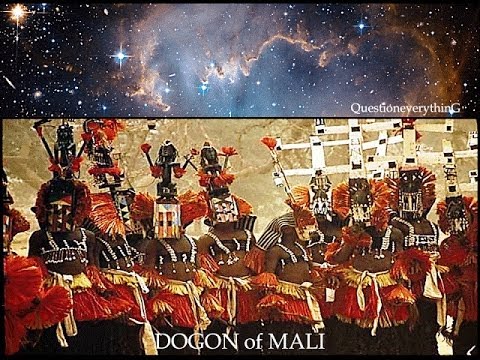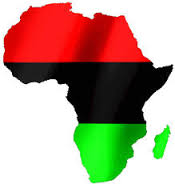
The Dogon people are an indigenous tribe who occupy a region in Mali, south of the Sahara Desert in Africa. There are about 800,000 members in the tribe.
They are a reclusive tribe of cave and hillside-dwelling farming people inhabiting a sparse, rocky plateau in southeastern Mali, West Africa. They live in the Homburi Mountains near Timbuktu.
Isolated topographically and culturally from the outside world for countless centuries, they may well appear on first sight to be exceedingly unlikely receptacles of highly advanced astronomical knowledge which only goes to show just how easily we can be deceived by outward appearances.
They are believed to be of Egyptian descent. After living in Libya for a time, they settled in Mali, West Africa, bringing with them astronomy legends dating from before 3200 BC. The first Western scientists to visit and study the Dogon people were French anthropologists Drs Marcel Griaule and Germaine Dieterlen, who initially made contact with them in 1931, and continued to research them for the next three decades, culminating in a detailed study conducted between 1946-1950. During their work, these anthropologists documented the traditional mythology and sacred beliefs of the Dogon, which included an extraordinary body of ancient lore regarding Sirius the brilliant, far-distant Dog Star.
Their priests told them of a secret Dogon myth about the star Sirius (8.6 light years from the Earth. The priests said that Sirius had a companion star that was invisible to the human eye. They also stated that the star moved in a 50-year elliptical orbit around Sirius, that it was small and incredibly heavy, and that it rotated on its axis.
Sirius – which we now call Sirius A – was not seen through a telescope until 1862 and was not photographed until 1970.
The Dogon name for Sirius B (Po Tolo) consists of the word for star (tolo) and “po,” the name of the smallest seed known to them. By this name they describe the star’s smallness — it is, they say, “the smallest thing there is.” They also claim that it is “the heaviest star,” and white.
The tribe claims that Po is composed of a mysterious, super-dense metal called sagala which, they declare, is heavier than all the iron on Earth. Not until 1926 did Western science discover that this tiny star is a white dwarf a category of star characterized by very great density. In the case of Sirius B, astronomers have estimated that a single cubic metre of its matter weighs about 20,000 tons.
Many artifacts were found describing the star system, including a statue examined by Dieterlen that is at least 400 years old.
They go on to say that it has an is elliptical orbit, with Sirius A at one foci of the ellipse (as it is), that the orbital period is 50 years (the actual figure is 50.04 +/- 0.09 years), and that the star rotates on its own axis (it does).
The Dogon also describe a third star in the Sirius system, called “Emme Ya” (“Sorghum Female”). In orbit around this star, they say, is a single satellite. To date, Emme Ya has not been identified by astronomers. In addition to their knowledge of Sirius B, the Dogon mythology includes Saturn’s rings, and Jupiter’s four major moons. They have four calendars, for the Sun, Moon, Sirius, and Venus, and have long known that planets orbit the sun. The Dogon say their astronomical knowledge was given to them by the Nommos, amphibious beings sent to Earth from Sirius for the benefit of mankind. The name comes from a Dogon word meaning ‘to make one drink’, and the Nommos are also called ‘Masters of the Water’, the ‘Monitors’, and the ‘Teachers’. Nommos
The Dogon tells the legend of the Nommos, awful-looking beings who arrived in a vessel along with fire and thunder. After they arrived here – they put out a reservoir of water onto the Earth then dove into the water.
There are references in the oral traditions, drawings and cuneiform tablets of the Dogons, to human looking beings who have feet but who are portrayed as having a large fish skin running down their bodies.
The Nommos were more fishlike than human, and had to live in water. They were saviors and spiritual guardians: “The Nommo divided his body among men to feed them; that is why it is also said that as the universe “had drunk of his body,” the Nommo also made men drink. He gave all his life principles to human beings.”
Watching the Nommo arrive
The Nommo was crucified and resurrected and in the future will again visit the Earth, this time in human form. Later he will assume his amphibious form and will rule the world from the waters.
Dogon mythology is known only by a number of their priests, and is a complex system of knowledge. Such carefully guarded secrets would not be divulged to friendly strangers very easily. If the star Emme Ya is eventually discovered in the Sirius system, this would give considerably weight to the Dogon’s story.
The Nommos, who could live on land but dwelled mostly in the sea, were part fish, like merfolk (mermaids and mermen). Similar creatures have been noted in other ancient civilizations – Sumer, Babylonia’s Oannes, Acadia’s Ea, Sumer’s Enki, and Egypt’s goddess Isis. It was from the Nommos that the Dogon claimed their knowledge of the heavens. The Dogon also claimed that a third star (Emme Ya) existed in the Sirius system. Larger and lighter than Sirius B, this star revolved around Sirius as well. And around it orbited a planet from which the Nommos came. (Sirius A).
Reviewed: Idhi Jarrabi
